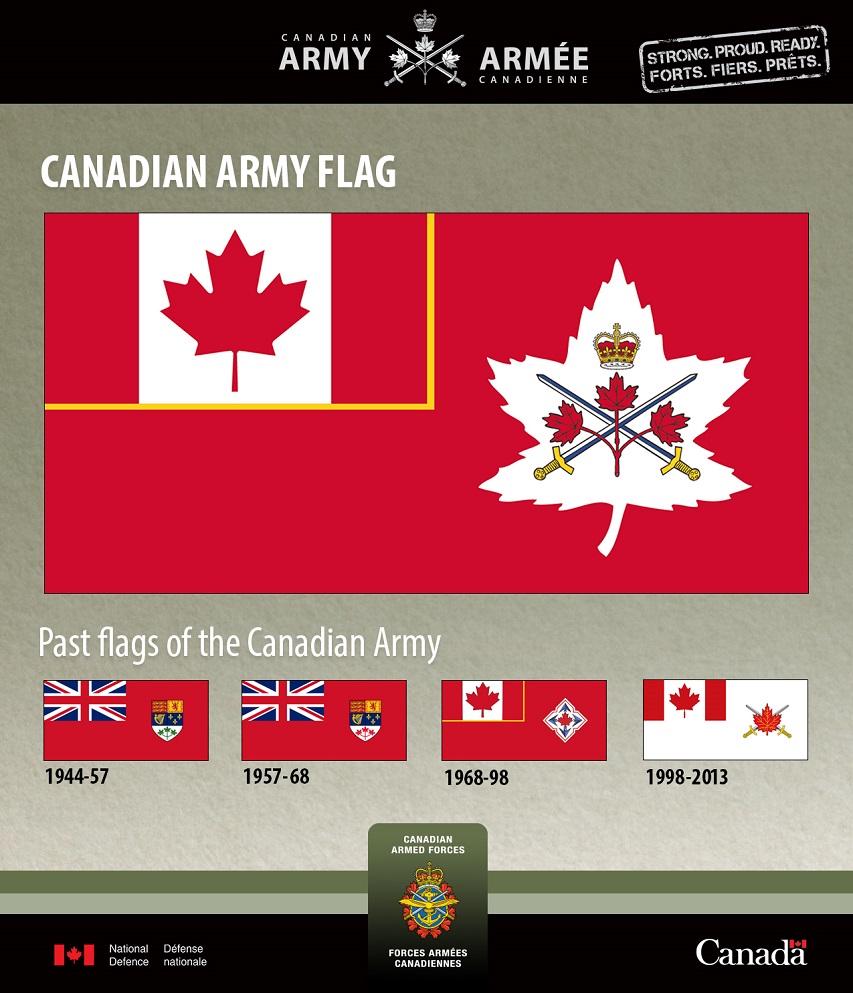Published on 31 Jul 2016
We thought about a list of misconceptions about World War 1 that don’t want to die even 100 years later.
August 1, 2016
Top 10 Misconceptions About World War 1 I THE GREAT WAR Special
A new flag for the Canadian Army
Chris Banks posted a link to this article in the Lorne Scots Facebook group:

The Canadian Army (CA) will advance into the future under a new flag that nods to its proud past.
The flag was unveiled July 14, 2016, during a ceremony on Parliament Hill in which CA members welcomed their new Commander, Lieutenant-General Paul Wynnyk.
The new design features the Canadian flag and a white, stylized maple leaf against a red background. Superimposed on the white maple leaf is the badge that members used during the Second World War and the Korean conflict, consisting of three maple leaves over a pair of crossed swords. Sitting atop the centre leaf is an image of St. Edward’s Crown, a symbol that has been used in coronation ceremonies for over 300 years.
The maple leaf was worn on the collars of Canadian soldiers who fought in the Battle of Vimy Ridge during the First World War, and was included on the new flag to honour the 100th anniversary of the battle, which will be marked in 2017. The same maple leaf flew on the Headquarters flags of the fighting Divisions during the Second World War and still flies across Canada at the CA’s various Division Headquarters.
QotD: Heinlein versus Pournelle
I took some heat recently for describing some of Jerry Pournelle’s SF as “conservative/militarist power fantasies”. Pournelle uttered a rather sniffy comment about this on his blog; the only substance I could extract from it was that Pournelle thought his lifelong friend Robert Heinlein was caught between a developing libertarian philosophy and his patriotic instincts. I can hardly argue that point, since I completely agree with it; that tension is a central issue in almost everything Heinlein ever wrote.
The differences between Heinlein’s and Pournelle’s military SF are not trivial — they are both esthetically and morally important. More generally, the soldiers in military SF express a wide range of different theories about the relationship between soldier, society, and citizen. These theories reward some examination.
First, let’s consider representative examples: Jerry Pournelle’s novels of Falkenberg’s Legion, on the one hand, and Heinlein’s Starship Troopers on the other.
The difference between Heinlein and Pournelle starts with the fact that Pournelle could write about a cold-blooded mass murder of human beings by human beings, performed in the name of political order, approvingly — and did.
But the massacre was only possible because Falkenberg’s Legion and Heinlein’s Mobile Infantry have very different relationships with the society around them. Heinlein’s troops are integrated with the society in which they live. They study history and moral philosophy; they are citizen-soldiers. Johnnie Rico has doubts, hesitations, humanity. One can’t imagine giving him orders to open fire on a stadium-full of civilians as does Falkenberg.
Pournelle’s soldiers, on the other hand, have no society but their unit and no moral direction other than that of the men on horseback who lead them. Falkenberg is a perfect embodiment of military Führerprinzip, remote even from his own men, a creepy and opaque character who is not successfully humanized by an implausible romance near the end of the sequence. The Falkenberg books end with his men elevating an emperor, Prince Lysander who we are all supposed to trust because he is such a beau ideal. Two thousand years of hard-won lessons about the maintenance of liberty are thrown away like so much trash.
In fact, the underlying message here is pretty close to that of classical fascism. It, too, responds to social decay with a cult of the redeeming absolute leader. To be fair, the Falkenberg novels probably do not depict Pournelle’s idea of an ideal society, but they are hardly less damning if we consider them as a cautionary tale. “Straighten up, kids, or the hero-soldiers in Nemourlon are going to have to get medieval on your buttocks and install a Glorious Leader.” Pournelle’s values are revealed by the way that he repeatedly posits situations in which the truncheon of authority is the only solution. All tyrants plead necessity.
Eric S. Raymond, “The Charms and Terrors of Military SF”, Armed and Dangerous, 2002-11-13.



